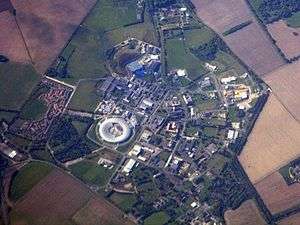Harwell Science and Innovation Campus

The Harwell Science and Innovation Campus is a science and technology campus near the villages of Harwell and Chilton, Oxfordshire, England. The site is 2 miles (3 km) outside Didcot, about 15 miles (24 km) south of Oxford and roughly 6 miles (10 km) east of Wantage. A large part of the site was formerly the main research establishment of the United Kingdom Atomic Energy Authority, but it has seen a transition to its new role as a science and business park as the nuclear facilities have been decommissioned.
History
Atomic Energy Research Establishment
The northern part of the Campus was formerly the Atomic Energy Research Establishment, which was created after the Second World War on the site of RAF Harwell. It was the main centre for atomic energy research and development in the United Kingdom from the 1940s to the 1990s, latterly being amalgamated into the United Kingdom Atomic Energy Authority. A number of test nuclear reactors were sited on the Campus over the years. The nuclear facilities are in the hands of the Nuclear Decommissioning Authority. As parts of the site are decommissioned, they are delicensed and dedesignated and no longer secured hence the area "inside the fence" is gradually shrinking. It is planned that the entire site will be decommissioned by 2025.[1]
Harwell International Business Centre
As the former UKAEA site was being decommissioned, a new role became necessary to maintain levels of employment in the area, building on the site's reputation for pioneering research, and ensuring that Harwell remained one of the UK's major centres for science and technology. Therefore, in 1996, it was relaunched as a business park.[2] One of the businesses on-site is the UKAEA spin-off company AEA Technology. As well as attracting numerous other hi-tech businesses, the Harwell IBC also boasted numerous amenities such as a bank, post office, hairdresser, sports facilities including a cricket pitch, and its own bus station.[3]
Rutherford Appleton Laboratory
In 1957 the Rutherford High Energy Laboratory (now the Rutherford Appleton Laboratory, RAL) was established on a site immediately south of the AERE. This was followed in 1961 by the Atlas Computer Laboratory, absorbed into the Rutherford in 1974. The southern site, including the RAL, became known as the Chilton/Harwell Science Campus. RAL is operated by the Science and Technology Facilities Council (STFC), and its facilities include the ISIS neutron source. Between 2003 and 2007 the Diamond synchrotron was constructed on the RAL site, the UK's largest scientific investment for 30 years.[4]
European Space Agency ECSAT (Roy Gibson Building)[5]
The European Space Agency moved into Harwell Science and Innovation Campus on May 2013. It was the first ESA base in the UK. ESA then constructed and opened the Roy Gibson Building (named after ESA’s first Director General) on July 2015. The ESA facility, named European Centre for Space Applications and Telecommunications or ECSAT focuses upon three key areas: combining data and images from space to create new applications for everyday life; observations and research on climate change (the facility hosts ESA's Climate Office); and the development of novel power sources and innovative robotic technologies to explore space.
Creation of the campus
In March 2006 the government announced plans to transform the Harwell International Business Centre into the Harwell Science and Innovation Campus.[6] In August 2006 the government announced an investment of £26.4 million to construct new research facilities on the campus[7] and the creation of a joint venture partnership to deliver the vision of creating a world leading location for science, innovation and enterprise.
The campus today
Over 5,500 people work on the campus in some 240 organisations.[8] Major companies and organisations on the site include:
- United Kingdom Atomic Energy Authority
- The STFC Rutherford Appleton Laboratory
- Diamond Light Source
- Medical Research Council
- Public Health England
- European Space Agency
- AMEC Foster Wheeler
- Nuvia
- AEA Technology
- Jisc
The campus is owned by the UKAEA, the Science and Technology Facilities Council and Public Health England.[9] It is managed by the Harwell Science and Innovation Campus joint venture partnership.
References
- ↑ Harwell Lifetime Plan 2006/07, Nuclear Decommissioning Authority
- ↑ "Harwell history". research-sites.com.
- ↑ Harwell Science and Innovation Campus: Amenities
- ↑ "Science/Nature – Diamond facility starts to shine". BBC. 14 July 2006.
- ↑ "Flags Are Raised at ESA's First UK Centre". www.spaceref.com. Retrieved 2016-09-21.
- ↑ Science and innovation investment framework 2004–2014: next steps para 3.13
- ↑ "Gold". EGOV Monitor (Press release). 16 August 2006. Archived from the original on 10 July 2011.
- ↑ "HSIC website". harwell.org.uk.
- ↑ HSIC website